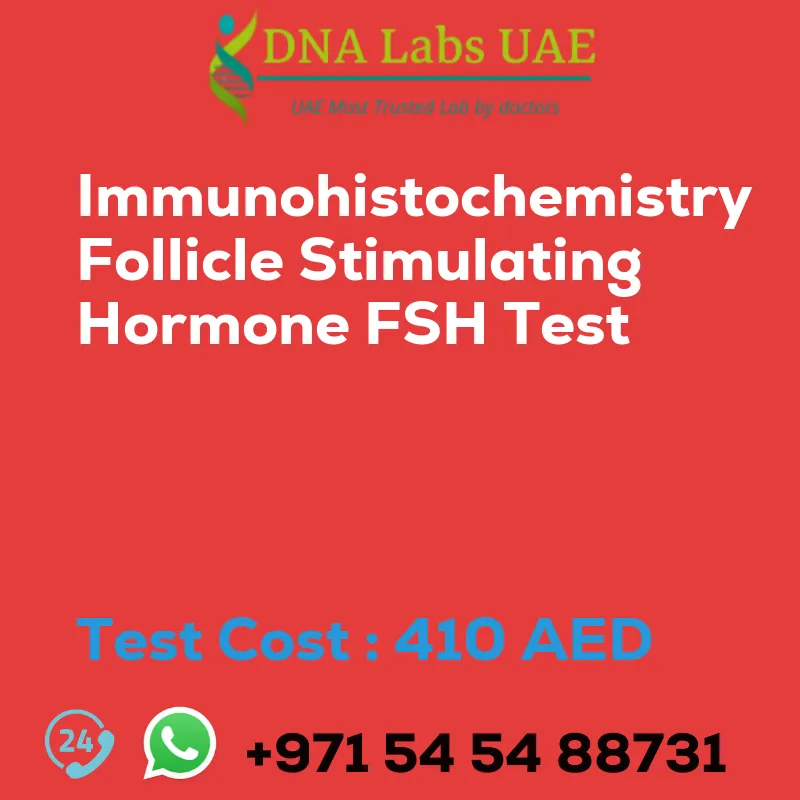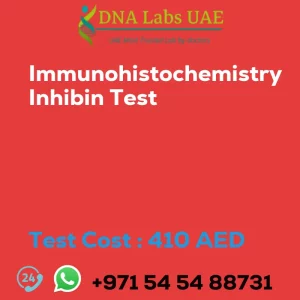IMMUNOHISTOCHEMISTRY FOLLICLE STIMULATING HORMONE FSH Test
At DNA Labs UAE, we offer the IMMUNOHISTOCHEMISTRY FOLLICLE STIMULATING HORMONE (FSH) Test. This test is used to detect and localize FSH in tissue samples. It is commonly used in the diagnosis and study of reproductive disorders, hormone-secreting tumors, and fertility issues.
Test Details
The IMMUNOHISTOCHEMISTRY (IHC) technique is used to detect specific proteins in tissue sections using antibodies. In the case of the FSH test, IHC is used to detect and localize FSH in tissue samples. The following steps are typically followed:
- Tissue preparation: Tissue samples obtained from biopsies or surgical resections are fixed in formalin and embedded in paraffin wax to create tissue blocks. Thin sections are then cut from the tissue blocks and mounted onto glass slides.
- Deparaffinization and rehydration: The paraffin wax is removed from the tissue sections using organic solvents. The sections are then rehydrated using graded alcohol solutions.
- Antigen retrieval: Formalin fixation can hinder antibody binding, so antigen retrieval is performed to expose the antigenic sites. This step is crucial for FSH detection and can be achieved through heat or enzymatic digestion.
- Blocking: To prevent non-specific antibody binding, the tissue sections are incubated with a blocking solution containing normal serum or bovine serum albumin.
- Primary antibody incubation: The tissue sections are incubated with a primary antibody specific to FSH. The primary antibody recognizes and binds to the FSH protein present in the tissue sections.
- Secondary antibody incubation: After washing off any unbound primary antibody, the tissue sections are incubated with a secondary antibody conjugated to a detection system. The secondary antibody recognizes and binds to the primary antibody, amplifying the signal.
- Visualization: The detection system used in the secondary antibody may involve enzymatic reactions or fluorescence. Enzymatic detection involves the addition of a chromogen substrate, resulting in a color change at the site of FSH protein localization. Fluorescence detection uses a fluorophore, and the FSH protein appears as a fluorescent signal under a fluorescence microscope.
- Counterstaining and mounting: To enhance tissue visualization and contrast, a counterstain, such as hematoxylin, may be applied. After counterstaining, the tissue sections are dehydrated, cleared, and mounted with a coverslip.
- Microscopic examination: The FSH protein localization can be observed and analyzed under a light microscope or a fluorescence microscope. The presence, intensity, and cellular localization of FSH staining provide valuable information about the tissue’s FSH expression pattern.
Test Cost and Sample Requirements
The cost of the IMMUNOHISTOCHEMISTRY FOLLICLE STIMULATING HORMONE FSH Test is 410.0 AED. To perform the test, please submit tumor tissue in 10% Formal-saline or Formalin fixed paraffin embedded block. The sample should be shipped at room temperature. Additionally, provide a copy of the Histopathology report, site of biopsy, and clinical history.
Report Delivery
The report for the IMMUNOHISTOCHEMISTRY FOLLICLE STIMULATING HORMONE FSH Test is delivered as follows:
- Sample: Daily by 6 pm
- Report Block: 5 days
- Tissue Biopsy: 5 days
- Tissue large complex: 7 days
Test Type and Doctor
The IMMUNOHISTOCHEMISTRY FOLLICLE STIMULATING HORMONE FSH Test falls under the category of cancer tests. It is typically ordered by oncologists and pathologists.
Pre Test Information
Prior to the test, please provide a copy of the Histopathology report, site of biopsy, and clinical history.
Overall, the IMMUNOHISTOCHEMISTRY FOLLICLE STIMULATING HORMONE FSH Test offered by DNA Labs UAE is a valuable tool for studying reproductive disorders, evaluating hormone-secreting tumors, and investigating fertility issues. It allows for the visualization and characterization of FSH protein expression in tissue samples, providing insights into its role and distribution within the tissue.
| Test Name | IMMUNOHISTOCHEMISTRY FOLLICLE STIMULATING HORMONE FSH Test |
|---|---|
| Components | |
| Price | 410.0 AED |
| Sample Condition | Submit tumor tissue in 10% Formal-saline OR Formalin fixed paraffin embedded block. Ship at room temperature. Provide a copy of the Histopathology report, Site of biopsy and Clinical history. |
| Report Delivery | Sample Daily by 6 pm; Report Block: 5 days Tissue Biopsy: 5 days Tissue large complex : 7 days |
| Method | Immunohistochemistry |
| Test type | Cancer |
| Doctor | Oncologist, Pathologist |
| Test Department: | |
| Pre Test Information | Provide a copy of the Histopathology report, Site of biopsy and Clinical history. |
| Test Details |
Immunohistochemistry (IHC) is a technique used to detect specific proteins in tissue sections using antibodies. In the case of the follicle-stimulating hormone (FSH) test, IHC can be used to detect and localize FSH in tissue samples. To perform the FSH immunohistochemistry test, the following steps are typically followed: 1. Tissue preparation: Tissue samples, usually obtained from biopsies or surgical resections, are fixed in formalin and embedded in paraffin wax to create tissue blocks. Thin sections (4-6 micrometers) are then cut from the tissue blocks and mounted onto glass slides. 2. Deparaffinization and rehydration: The paraffin wax is removed from the tissue sections by treating them with xylene or other organic solvents. The sections are then rehydrated by passing them through a series of graded alcohol solutions. 3. Antigen retrieval: Formalin fixation can cause protein cross-linking, which can hinder antibody binding. To expose the antigenic sites, antigen retrieval is performed by subjecting the tissue sections to heat or enzymatic digestion. This step is crucial for FSH detection. 4. Blocking: To prevent non-specific antibody binding, the tissue sections are incubated with a blocking solution containing normal serum or bovine serum albumin. 5. Primary antibody incubation: The tissue sections are then incubated with a primary antibody specific to FSH. The primary antibody recognizes and binds to the FSH protein present in the tissue sections. 6. Secondary antibody incubation: After washing off any unbound primary antibody, the tissue sections are incubated with a secondary antibody conjugated to a detection system. The secondary antibody recognizes and binds to the primary antibody, amplifying the signal. 7. Visualization: The detection system used in the secondary antibody may involve enzymatic reactions or fluorescence. For enzymatic detection, a chromogen substrate is added, resulting in a color change at the site of FSH protein localization. For fluorescence detection, a fluorophore is used, and the FSH protein appears as a fluorescent signal under a fluorescence microscope. 8. Counterstaining and mounting: To enhance tissue visualization and contrast, a counterstain, such as hematoxylin, may be applied. After counterstaining, the tissue sections are dehydrated, cleared, and mounted with a coverslip. 9. Microscopic examination: The FSH protein localization can be observed and analyzed under a light microscope or a fluorescence microscope. The presence, intensity, and cellular localization of FSH staining can provide valuable information about the tissue’s FSH expression pattern. The FSH immunohistochemistry test can be used in various research and diagnostic applications, such as studying reproductive disorders, evaluating hormone-secreting tumors, or investigating fertility issues. It allows for the visualization and characterization of FSH protein expression in tissue samples, providing insights into its role and distribution within the tissue. |








